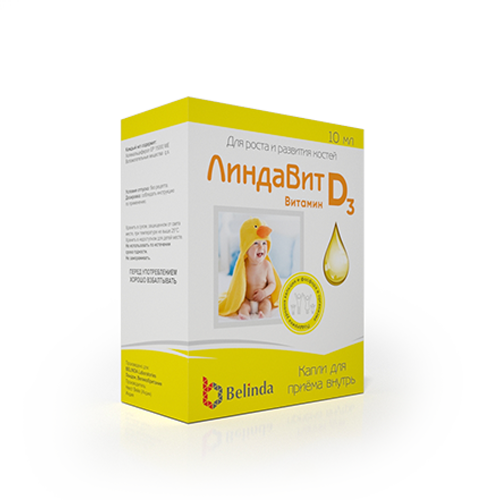
Lindavit Drops
Over the counter
Vitamin D3 is an active antirachitic factor. The most important function of vitamin D3 is to regulate calcium and phosphate metabolism, which promotes proper mineralization and skeletal growth.
Manual
each ml contains:
- Cholecalciferol EP 15,000 IU
- Excipients q.s.
- prevention and treatment of rickets;
- prevention of vitamin D deficiency in high-risk groups (malabsorption, chronic diseases of the small intestine, biliary cirrhosis of the liver, conditions after resection of the stomach
- and/or small intestine);
- hypocalcemia;
- hypocalcemic tetany;
- treatment of osteoporosis (of various origins);
- treatment of osteomalacia (against the background of mineral metabolism disorders in patients over 45 years of age, prolonged immobilization in case of injury, adherence to diets that
- exclude milk and dairy products);
- treatment of hypoparathyroidism and pseudohypoparathyroidism.
The drug is taken orally with a small amount of liquid. 1 drop contains about 500 IU of vitamin D3.
Prophylactic doses:
Full-term newborns from 4 weeks of life to 2-3 years of life with proper care and sufficient exposure to fresh air – 500 IU (1 drop) per day;
Premature newborns from 4 weeks of life, as well as twins, infants in poor living conditions – 1000 IU (2 drops) per day for one year. In the summer, you can limit the dose to 500 IU (1 drop) per day. The duration of therapy is up to 2-3 years of life;
Pregnant women – a daily dose of 500 IU of vitamin D3 for the entire period of pregnancy, or 1000 IU per day from the 28th week of pregnancy;
For postmenopausal women – 500 – 1000 IU (1-2 drops) per day, for 2-3 years, the doctor decides on the need for repeated courses of therapy.
Therapeutic doses:
For rickets, start with 2000 IU for 3-5 days, then, if well tolerated, the dose is increased to an individual therapeutic dose of 2000 – 5000 IU (4-10 drops) daily, most often 3000 IU, depending on the severity of rickets (I, II , or III) and the course of the disease, for 4-6 weeks, under careful monitoring of the clinical condition and the study of biochemical parameters (calcium, phosphorus, alkaline phosphatase) of blood and urine. A dose of 5000 IU is prescribed only for pronounced bone changes.
If necessary, after a one-week break, you can repeat the course of treatment. Treatment is carried out until a clear therapeutic effect is obtained, followed by a transition to a prophylactic dose of 500 – 1500 IU per day. The duration of the course of treatment and prevention is determined by the doctor.